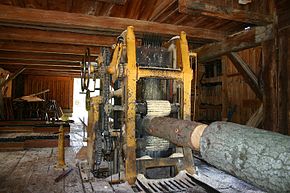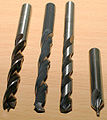Woodworking
The term woodworking describes the basic techniques for processing and manufacturing wooden surfaces . These techniques are the basis for wood processing . The shaping processing methods are either machining or abrasive (scraping). Coloring or structuring processing methods also fall under the term woodworking, but are of a decorative nature.
Woodworking methods include a. Sawing, splitting, planing, drilling, scraping, grinding and carving - also surface treatment using paints, chemicals, varnishes and oils.
Woodworking is used in a wide variety of professions, such as B. carpenter , carpenter , sawmill and wood turner . But also boat builders , plucked instrument makers and piano makers . In the artistic field there are the carvers .
Wood tools
Tools have always been used to work with wood. While these were originally very primitive made of flint and bone , our modern woodworking tools have developed over the millennia through the use of newly discovered metals such as copper , bronze , iron and steel . These tools are used to structure wood. This means that there is always less material after processing than in the original product. These waste products are called chips , dust or sawdust .
These tools come in different shapes and sizes, some of which are very different from one another. Therefore, only the basic forms are listed below.
Woodworking machines
In modern woodworking companies, motorized tools are predominantly used. Machines with combustion engines , electric motors and pneumatic drives are used. A pneumatic drive prevents sparks that could trigger a dust explosion . Machines with a combustion engine can only be operated outside of closed rooms. To this day, water wheels are occasionally used to drive their power is transmitted to the machines via transmission .
All machines are available in different designs and shapes, depending on the requirements as a stationary device or as a hand machine.
- Chainsaws
- Gang saws
- Band saws
- Circular saws
- Thickness planers
- Surface planers
- Drilling machines
- Wood lathe
- Grinding machines
- Milling
Surface treatment
In addition to traditional scrapers , machining processes without a geometrically defined cutting edge are mainly used to process the surfaces of wood-based materials .
After planing and milling, surfaces are usually prepared for coating by several sanding steps .
To uneven surfaces to edit or grain work out of the wood plastic be with abrasive filaments or metal wire occupied brushes on mobile or stationary brushes machines used. See brush chips
Surface treatment
To protect against the effects of the weather and mechanical stress, paints , waxes and oils are used, which can also be pigmented . Waxes are not weather-resistant and do not penetrate the wood. They can close the pores of the wood, make the surface supple and create a shine, but must be reapplied at certain intervals after mechanical stress.
The natural color of the wood can by means of bleaching agents (such as oxalic acid and hydrogen peroxide ) and alkaline solutions (such as soapy water or sodium hydroxide solution ) and brightened by pickling ( dyeing ) are changed.
The impregnation provides protection against mold , rot and wood pests . Impregnations are the lumber often colored for identification.
Other types of processing
Bending and steaming are special forms of woodworking because they give shape, but no material is removed.
photos
literature
- Wolfgang Nutsch and others; Expertise for carpenters , 12th edition, Verlag Europa-Lehrmittel OHG, Wuppertal 1981, ISBN 3-8085-4011-7
- Hårvard Bergland: The art of forging. The great textbook of traditional technology. 4th, unchanged edition of the German edition. Wieland, Bruckmühl 2013, ISBN 978-3-9808709-4-8 , pp. 107–162: Chapter 7: Forging tools for woodworking .
- Edgar Finsterbusch, Werner Thiele: From stone ax to saw gate. A journey through the history of woodworking . Leipzig 1983.










